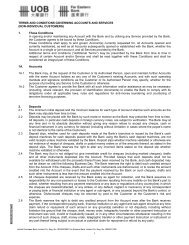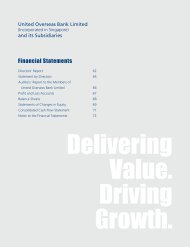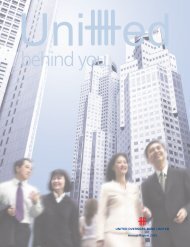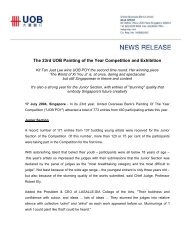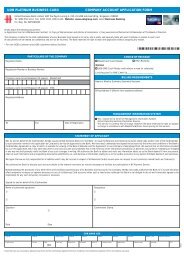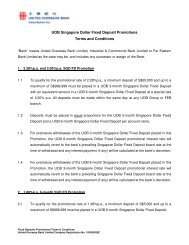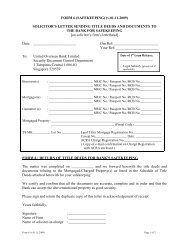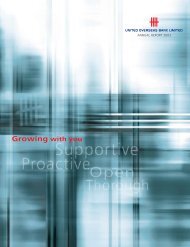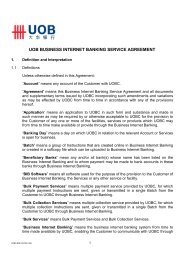Risk Management Country Risk International lending involves additional risks compared to domestic lending in that there may be impediments arising from events in a foreign country that prevent repayment of the foreign borrowers' obligations to the Group. Such events may affect all borrowers of the same country. As such, it is important to set limits to safeguard various facets of the Group’s exposures to any single country. Country exposure aggregates all exposures to a particular country, irrespective of whether such exposures are booked in or outside of that particular country. The exposure may be in the form of actual assets, such as investments, real estate, loan assets, contingent exposures like letters of credit and guarantees, other off-balance sheet exposures like foreign exchange contracts, interest rate/currency swaps or collateral/guarantees located in the country to secure exposures booked in another country. Cross-border exposure is the summation of all country exposures, including intra-group exposures but excluding facilities provided by the Group's branches/subsidiaries to the local incorporation or residual risk remaining within a country. Setting of Country/Cross-Border Limits The review of country and cross-border risk by Risk Management & Compliance Sector – Country & Credit Risk Management is managed through a system of country and cross-border limits, based on ratings by external rating agencies and internal country credit grading. The latter uses various quantitative key indicators as well as qualitative factors relating to each country's economic, social and political circumstances. The scores are averaged and applied to a standard scale to obtain a numeric rating for the country. This numeric rating is then used to determine the appropriate limits based on a risk scale that assigns more stringent limits to countries where the Group does not have a presence. The limit setting process also takes into account the size of the <strong>Bank</strong>'s capital, the perceived economic strength and stability of the borrowing country, and the assessment of the Group’s portfolio spread and risk appetite. Mitigation of Country/Cross-Border Risk The Group's country and cross-border limits, aimed at avoiding concentration of transfer, economic or political risks, are regularly reviewed and exposure is reported to the Credit Committee at least four times a year. Limits may be reviewed and business strategies revised as and when necessary, based on updates by country managers and/or business development managers together with an assessment of current events and developments for each country. The country/cross-border risk ceiling is the primary limit for all transactions across all counter-parties. Extension of credit may thus be denied where a country/cross-border risk ceiling is reached although sufficient counterparty limits are available. Group Exposure by Country of Operations The Group's total direct exposure to the countries (outside Singapore) in which it has a presence amounted to $29.1 billion as at 31 December <strong>2002</strong>, or 27% of Group total assets. Exposure (excluding contingent) reported is segregated by loans and advances to customers, balances due from banks incorporated in the country, investments and balances due from the government. 36
Exposure to the Five Regional Countries, Greater China and Others Loans and Debt Securities Less: Loans/ Net Exposure –––––––––––––––––––––––––––––––––––––––––––––––– –––––––––––––––––––––––––––––– Investments in Subsidiaries % of Group Contingent $ million Non-<strong>Bank</strong> Government <strong>Bank</strong> Investments Total & Branches Amount Total Assets Liabilities –––––––––––––––––––––––––––––––––––––––––––––––––––––––––––––––––––––––––––––––––––––––––––––––––––––––––––––––––––––––––––––––––––––––––––––––––––––––––––––––––––––––––––––––––––––––––––––––––––––––––––––––– Malaysia 31.12.02 6,164 1,990 2,381 530 11,065 1,498 9,567 8.9 1,032 30.6.02 6,014 2,648 2,229 615 11,506 1,286 10,220 9.4 872 31.12.01 6,493 2,188 2,571 740 11,992 2,017 9,975 8.8 864 31.12.00 3,165 993 1,118 470 5,746 579 5,167 7.8 476 Indonesia 31.12.02 444 127 106 74 751 50 701 0.6 67 30.6.02 449 141 98 55 743 32 711 0.6 48 31.12.01 331 118 155 55 659 75 584 0.5 27 31.12.00 301 45 79 35 460 34 426 0.6 39 Philippines 31.12.02 254 225 44 10 533 31 502 0.5 56 30.6.02 290 200 42 43 575 66 509 0.5 47 31.12.01 300 277 46 33 656 65 591 0.5 6 31.12.00 274 210 102 66 652 150 502 0.8 1 Thailand 31.12.02 1,178 1,177 112 200 2,667 194 2,473 2.3 285 30.6.02 1,127 1,355 279 174 2,935 325 2,610 2.4 285 31.12.01 1,026 1,617 567 261 3,471 594 2,877 2.5 180 31.12.00 419 1,648 66 190 2,323 165 2,158 3.3 225 South Korea 31.12.02 45 591 1,354 95 2,085 12 2,073 1.9 253 30.6.02 63 241 1,329 204 1,837 404 1,433 1.3 132 31.12.01 57 82 888 174 1,201 140 1,061 0.9 229 31.12.00 18 51 832 107 1,008 5 1,003 1.5 63 –––––––––––––––––––––––––––––––––––––––––––––––––––––––––––––––––––––––––––––––––––––––––––––––––––––––––––––––––––––––––––––––––––––––––––––––––––––––––––––––––––––––––––––––––––––––––––––––––––––––––––––––– Total Regional Countries 31.12.02 8,085 4,110 3,997 909 17,101 1,785 15,316 14.2 1,693 30.6.02 7,943 4,585 3,977 1,091 17,596 2,113 15,483 14.2 1,384 31.12.01 8,207 4,282 4,227 1,263 17,979 2,891 15,088 13.2 1,306 31.12.00 4,177 2,947 2,197 868 10,189 933 9,256 14.0 804 –––––––––––––––––––––––––––––––––––––––––––––––––––––––––––––––––––––––––––––––––––––––––––––––––––––––––––––––––––––––––––––––––––––––––––––––––––––––––––––––––––––––––––––––––––––––––––––––––––––––––––––––– Greater China 31.12.02 2,482 233 4,311 632 7,658 2,536 5,122 4.8 504 30.6.02 2,798 112 3,884 539 7,333 2,501 4,832 4.4 451 31.12.01 2,912 135 2,740 590 6,377 1,904 4,473 3.9 446 31.12.00 1,052 101 1,328 213 2,694 637 2,057 3.1 177 –––––––––––––––––––––––––––––––––––––––––––––––––––––––––––––––––––––––––––––––––––––––––––––––––––––––––––––––––––––––––––––––––––––––––––––––––––––––––––––––––––––––––––––––––––––––––––––––––––––––––––––––– Other OECD 31.12.02 4,847 105 4,647 687 10,286 1,862 8,424 7.8 878 30.6.02 4,151 51 3,645 547 8,394 1,010 7,384 6.8 908 31.12.01 4,652 49 6,102 604 11,407 1,307 10,100 8.9 734 31.12.00 2,207 32 6,358 138 8,735 262 8,473 12.8 584 –––––––––––––––––––––––––––––––––––––––––––––––––––––––––––––––––––––––––––––––––––––––––––––––––––––––––––––––––––––––––––––––––––––––––––––––––––––––––––––––––––––––––––––––––––––––––––––––––––––––––––––––– Others 31.12.02 154 11 35 4 204 4 200 0.2 47 30.6.02 161 11 36 5 213 4 209 0.2 22 31.12.01 187 12 44 1 244 4 240 0.2 27 31.12.00 7 4 19 – 30 9 21 – 22 –––––––––––––––––––––––––––––––––––––––––––––––––––––––––––––––––––––––––––––––––––––––––––––––––––––––––––––––––––––––––––––––––––––––––––––––––––––––––––––––––––––––––––––––––––––––––––––––––––––––––––––––– Grand Total 31.12.02 15,568 4,459 12,990 2,232 35,249 6,187 29,062 27.0 3,122 30.6.02 15,053 4,759 11,542 2,182 33,536 5,628 27,908 25.6 2,765 31.12.01 15,958 4,478 13,113 2,458 36,007 6,106 29,901 26.2 2,513 31.12.00 7,443 3,084 9,902 1,219 21,648 1,841 19,807 29.9 1,587 UNITED OVERSEAS BANK 37
- Page 1 and 2: ANNUAL REPORT 2002 United for Growt
- Page 3 and 4: Our Mission To be a premier bank in
- Page 5 and 6: Performance in Brief Profit For The
- Page 7 and 8: Profit growth was derived mainly fr
- Page 9 and 10: Financial Highlights Group Assets 2
- Page 11 and 12: Group Return On Average Shareholder
- Page 13 and 14: Corporate Information Honorary Life
- Page 15 and 16: Left to right: Koh Beng Seng, Ngiam
- Page 17 and 18: Left to right: Tan Kok Quan, Prof L
- Page 19 and 20: Mr Francis Lee Chin Yong Managing D
- Page 21 and 22: The Bank has a budget for directors
- Page 23 and 24: independent and non-executive direc
- Page 25 and 26: work of each of the banking subsidi
- Page 27 and 28: Risk Management Credit and Country
- Page 29 and 30: The composition of loans and advanc
- Page 31 and 32: Group Non-Performing Loans (NPLs) a
- Page 33 and 34: Group NPLs and Cumulative Provision
- Page 35 and 36: Group Specific Provision by Region
- Page 37: Collateral Types The majority of th
- Page 41 and 42: Cross-Border Exposure to the Five R
- Page 43 and 44: Complementing the static analysis i
- Page 45 and 46: Sources of Deposits The Group has a
- Page 47 and 48: The VaR calculations are performed
- Page 49 and 50: Group Daily VaR Distribution for 20
- Page 51 and 52: As part of the Group's comprehensiv
- Page 53 and 54: The celebratory light-up linking UO
- Page 55 and 56: services so as to meet the increasi
- Page 57 and 58: Our subsidiary, UOB Asset Managemen
- Page 59 and 60: Grow our services In line with the
- Page 61 and 62: exercise, achieved well ahead of th
- Page 63 and 64: processes in place that will suppor
- Page 65 and 66: Group Financial Review Review of Fi
- Page 67 and 68: Group Profits The Group achieved a
- Page 69 and 70: Analysis of Changes in Net Interest
- Page 71 and 72: Cost Savings from Integration The G
- Page 73 and 74: Overview of Balance Sheet Assets Mi
- Page 75 and 76: Gross Customer Loans Analysed by Cu
- Page 77 and 78: Capital Adequacy Ratios The Capital
- Page 79 and 80: Directors’ Report for the financi
- Page 81 and 82: In addition, the following subsidia
- Page 83 and 84: Arrangements to Enable Directors to
- Page 85 and 86: Ability to Meet Obligations No cont
- Page 87 and 88: Share Options of the Bank (a) From
- Page 89 and 90:
(d) (e) (f) No options have been gr
- Page 91 and 92:
Statement by Directors for the fina
- Page 93 and 94:
Income Statements for the financial
- Page 95 and 96:
The Group The Bank Note 2002 2001 2
- Page 97 and 98:
The Group 2001 Non- Share of Share
- Page 99 and 100:
The Bank 2001 Non- Share Share Dist
- Page 101 and 102:
Notes to the Financial Statements f
- Page 103 and 104:
(e) Investments (i) Singapore Gover
- Page 105 and 106:
(k) Derivative Financial Instrument
- Page 107 and 108:
4 Interest Expense The Group The Ba
- Page 109 and 110:
(c) Equity Compensation Benefits Op
- Page 111 and 112:
11 Directors’ Fees and Other Remu
- Page 113 and 114:
14 Tax (a) The tax charge to the in
- Page 115 and 116:
2002 2001 Fair Value of Depreciable
- Page 117 and 118:
Deferred tax assets and liabilities
- Page 119 and 120:
18 Non-Distributable Reserves (a) T
- Page 121 and 122:
19 Revenue Reserves (a) The Group 2
- Page 123 and 124:
(c) The interim dividend paid in sp
- Page 125 and 126:
23 Debts Issued The Group The Bank
- Page 127 and 128:
(b) Included in other government tr
- Page 129 and 130:
(c) Total gross trade bills and adv
- Page 131 and 132:
29 Other Assets The Group The Bank
- Page 133 and 134:
32 Investments in Subsidiaries (a)
- Page 135 and 136:
33 Movements in the Provisions for
- Page 137 and 138:
34 Fixed Assets (a) The Group 2002
- Page 139 and 140:
(e) Certain freehold and leasehold
- Page 141 and 142:
39 Derivative Financial Instruments
- Page 143 and 144:
(c) Derivative financial instrument
- Page 145 and 146:
The Group - 2001 Individual Institu
- Page 147 and 148:
(b) Secondary Reporting Format - Ge
- Page 149 and 150:
Discussions on the main financial r
- Page 151 and 152:
The Group - 2002 Hong Singapore US
- Page 153 and 154:
Other foreign exchange exposures of
- Page 155 and 156:
The Group - 2002 Non- Over 7 Over O
- Page 157 and 158:
The Group - 2001 Non- Over 7 Over O
- Page 159 and 160:
The Group - 2002 Over 7 Over Over O
- Page 161 and 162:
The Group - 2001 Over 7 Over Over O
- Page 163 and 164:
Where quoted and observable market
- Page 165 and 166:
Percentage of Paid-Up Capital Held
- Page 167 and 168:
Percentage of Paid-Up Capital Held
- Page 169 and 170:
Percentage of Paid-Up Capital Held
- Page 171 and 172:
Investor Reference Financial Highli
- Page 173 and 174:
1998 1997 1996 1995 1994 1993 1992
- Page 175 and 176:
1998 1997 1996 1995 1994 1993 1992
- Page 177 and 178:
Statistics of Shareholdings as at 1
- Page 179 and 180:
Changes in Share Capital The follow
- Page 181 and 182:
Our International Network Banking S
- Page 183 and 184:
United Overseas Bank (Malaysia) Bhd
- Page 185 and 186:
UOB Venture Management (Shanghai) C
- Page 187 and 188:
Notes to Resolutions 4, 6, 7, 8, 9,
- Page 189:
Notes: 1 Please insert the number o




